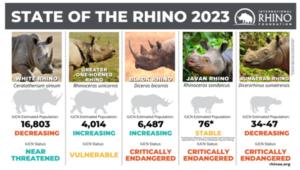Rhino Populations: A Mixed Picture.
Relevance
- GS Paper 3 Conservation, environmental pollution and degradation, environmental impact assessment.
- Tags: #rhino #IRF #india #currentaffairs #upsc.
Why in the News?
Recently, the International Rhino Foundation (IRF) published the report, State of the Rhino, 2023 which documents current population estimates and trends for the five surviving rhino species in Africa and Asia.
World Rhino Day, September 22nd, 2023
On World Rhino Day, we take stock of the current state of the world’s five rhino species, revealing a mixed scenario characterized by both hope and challenges.
Positive Trends
Black Rhinos and Greater One-Horned Rhinos
- Two species, the black rhino and the greater one-horned rhino, are experiencing population increases, thanks to conservation efforts and strong protection measures.
Concerns Persist
White Rhinos and Sumatran Rhinos
While there’s encouraging news of recent white rhino population growth, this is yet to establish itself as a long-term trend. Sumatran rhinos continue to face declines.
The Javan Rhino
The population trend of Javan rhinos remains unknown, leaving their status uncertain.
Threats to Rhino Survival
Rhino populations worldwide confront several threats, with the two most prominent ones being poaching and habitat loss, compounded by the growing impact of climate change.
The Peril of Poaching
- Rhino Horn Trade: Poaching for rhino horn remains the most significant threat to all five rhino species. Organized criminal syndicates have intensified their efforts, targeting even once less-threatened populations.
- Incidents and Investigations: India recently witnessed two poaching incidents in Kaziranga National Park and Manas National Park in 2023. Indonesia’s Ujung Kulon National Park, home to Javan rhinos, reported an alarming increase in incursion attempts and an ongoing investigation into an unnatural Javan rhino death.
- Changing Poaching Patterns: In Africa, poaching patterns have shifted from larger to smaller rhino populations, particularly impacting the white rhino, the most populous species. Conservation areas are ramping up security, but poachers have reacted by targeting smaller regions.
Climate Change Concerns
- Africa’s Drought Dilemma: Climate change-induced drought in Africa has multifaceted impacts on rhinos, including habitat loss, resource competition, increased human-wildlife conflicts, and a potential rise in poaching due to crop and livestock losses.
- Asia’s Precipitation Predicament: In Asia, intensified precipitation and prolonged monsoon periods pose direct threats to rhinos. Seasonal floods endanger greater one-horned rhinos, causing stranding and separation of calves from their mothers. Increased disease risk to both humans and rhinos is a looming concern.
- Habitat Disruption and Invasive Species: Changing weather patterns can lead to an increase in invasive plant species, disrupting native rhino food sources and degrading habitat quality.
Conservation Success Stories
Greater One-Horned Rhinos
Strong protection and enforcement have allowed greater one-horned rhinos to thrive. Authorities believe their population is growing in India and Nepal.
Black Rhinos
A cautious success story, black rhinos in Africa have rebounded in recent decades, showcasing the positive outcomes that dedicated conservation efforts, government commitment, and community engagement can achieve.
Rhinos In India
- Approximately 3,262 greater one-horned rhinos reside in India.
- Poaching Incidents.
- In 2022, one rhino experienced horn removal but survived.
- As of 2023, there have been two rhino poaching deaths.
- Manas National Park.
Rhino translocations to Manas National Park, originally planned for early 2023, were postponed to 2024. The delay is due to the need to reinforce security measures following the discovery of a poached rhino in January.
Orang National Park Expansion
- Over the past year, the Assam government finalized the addition of approximately 200 sq km to Orang National Park in north-central Assam.
- This expansion more than doubled the size of the protected area, which is crucial rhino habitat.
- The proactive step aims to create additional space for Assam’s growing rhino population and ensure its long-term growth and security.
- It facilitates rhino movement between protected areas.
Creation of Linked Corridor
- Orang National Park is now connected to Burhachapori Wildlife Sanctuary in the east.
- This completion forms a connected corridor between all protected areas in Assam where rhinos either currently reside or are planned to be relocated.
- The linked corridor encompasses Manas National Park, Pobitora Wildlife Sanctuary, Orang National Park, Laokhowa Wildlife Sanctuary, Burhachapori Wildlife Sanctuary, and Kaziranga National Park.
Key Takeaways From The 2023 State Of The Rhino Report
- Poaching still threatens all five rhino species and has increased in several regions that had not previously been targeted.
- South Africa continues to battle devastating poaching losses of its white rhinos as poachers target HluhluweImfolozi Game Reserve and other reserves within KwaZulu-Natal province.
- Black rhino populations are increasing despite constant poaching pressure.
- The greater one-horned rhino population in India and Nepal continues to grow thanks to strong protection, wildlife crime law enforcement and habitat expansion.
- The status and whereabouts of 12 of the approximately 76 remaining Javan rhinos is unknown.
- Signs of Sumatran rhinos are increasingly hard to find, creating more uncertainty about their population in the wild.
- 2,000 white rhinos from “World’s Largest Rhino Farm” will now be re-wilded throughout Africa.
While the road ahead is fraught with challenges, the successes of conservation efforts for greater one-horned and black rhinos underscore the potential for recovery across all five rhino species. With continued commitment, support, and intervention, rhinos can thrive in our ever-changing world.
|
International Rhino Foundation (IRF) Vision A thriving world where rhinos flourish in their natural habitats. Mission Ensure the survival of rhinos through strategic partnerships, targeted protection, and scientifically sound interventions. Core Values – Integrity: Foster honest, ethical, and trusting relationships with partners, staff, the public, and board members. – Collaboration: Partner with individuals and organizations committed to saving rhinos. – Adaptability: Resourcefully and innovatively apply expertise and funds in a changing landscape for rhino conservation. – Sound Decision-Making: Make decisions based on science, political realities, and available resources. – Commitment: Dedicate to making long-term tactical investments in key partners to conserve rhinos. History – Founded as the International Black Rhino Foundation in 1991 to combat poaching and stabilize Zimbabwe’s black rhino population. – Expanded in 1993 to become the International Rhino Foundation (IRF) to address the crisis facing all five rhino species. – Major programs include Rhino Protection Units, Sumatran Rhino Sanctuary, Javan Rhino Study, Indian Rhino Vision 2020, Lowveld Rhino Conservation Program, and Operation Stop Poaching Now. – Funded by over 1,000 individual members, zoos, foundations, corporations, and government agencies. – Governed by a dedicated Board of Directors contributing time and financial resources. – Program Office in Strasburg, VA (USA) and Business Office in Fort Worth, TX (USA). |
Sources: UNEP
Mains Question
“Examine the changing dynamics of rhino poaching, particularly in Africa and Asia, and its implications for rhino conservation as per State of the Rhino, 2023 report. How can conservation efforts adapt to these shifting patterns?” 250words.





